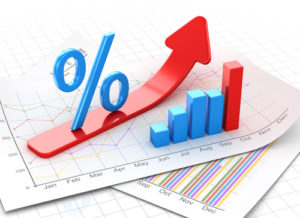There is something magical about compound interest. Einstein even called it the 8th wonder of the world. Or at least people say he did. Either way, it has the power to unlock serious wealth accumulation in the long term.
The best part? It’s so simple, even the most unsavvy investor can take advantage of its powers. The key is to get started with compound interest as soon as you can, no matter how small your investment is.
How Compound Interest Works
To understand how compound interest works, it’s helpful to understand first how simple interest works.
Now stay with me here, there are going to be some numbers in this post.
Simple Interest
Simple interest is calculated on the original amount of a deposit – called the principal.
For example, if you deposit $10,000 into your savings account (the principal) and the annual interest rate paid is 4% each year, as a result you will accrue $400 (4% of $10,000) in simple interest annually.
The calculation for simple interest works like this:
Principal (10,000) x Interest rate (0.04) x Number of years (5) = $2000
After depositing $10,000, with 4% simple interest annually, your account balance at the end of year 5 is $12,000.
| Year | Investment | Interest | Balance |
| 1 | $10,000 | $400 | $10,700 |
| 2 | $0 | $400 | $10,800 |
| 3 | $0 | $400 | $11,200 |
| 4 | $0 | $400 | $11,600 |
| 5 | $0 | $400 | $12,000 |
| Total | $10,000 | $2000 | $12,000 |
 Real wealth starts to become a reality when we look at the power of compound interest. In fact it is one of the things that the wealthy know and use that the rest don’t. You can learn more about that in my upcoming new course. Keep an eye on your email for details.
Real wealth starts to become a reality when we look at the power of compound interest. In fact it is one of the things that the wealthy know and use that the rest don’t. You can learn more about that in my upcoming new course. Keep an eye on your email for details.
Compound Interest
Now I can hear you screaming already at how unexciting those numbers are. There isn’t any real wealth happening with simple interest, I get that.
Compound interest is calculated on the principal amount and – this is where it gets exciting – on the interest accumulated in the previous period.
Basically, it’s interest on interest.
Here’s what a $10,000 principal deposit and 4% annual interest over 5 years using compound interest looks like.
| Year | Investment | Interest | Balance |
| 1 | $10,000 | $400.01 | $10,400.01 |
| 2 | $0 | $415.99 | $10,816.00 |
| 3 | $0 | $432.64 | $11,248.64 |
| 4 | $0 | $449.95 | $11,698.59 |
| 5 | $0 | $467.94 | $12,166.53 |
| Total | $10,000 | $2,166.53 | $12,166.53 |
With compound interest, the account balance at the end of year 5 is $12,166.53. That’s 1.38% more money, with no extra effort from you!
Now, 1.38% may not look like much of a difference between the simple and compound balance after 5 years but this gap widens exponentially with time and even more so with additional monthly contributions and a higher interest rte.
According to a recent Suncorp report, the average Aussie is socking away $427 in savings each month. So let’s take a look at the figures if you were to make an additional monthly contribution of $427 at 7% compound interest rate with your starting balance of $10,000.
| Year | Investment | Interest | Balance |
| 1 | $15,124.00 * | $892.29 | $16,016.28 |
| 2 | $5,124.00 | $1,313.40 | $22,453.69 |
| 3 | $5,124.00 | $1,764.03 | $29,341.73 |
| 4 | $5,124.00 | $2,246.21 | $36,711.93 |
| 5 | $5,124.00 | $2,762.12 | $44,598.048 |
| Total | $35,620.00 | $8,978.04 | $44,598.04 |
*Initial investment of $10,000 + monthly contributions
That’s starting to get interesting, there is some real power building up in the additional earnings each year.
Time Is The Secret Weapon Of Compound Interest
The real magic of compound interest reveals itself over time. This is why it’s important to get started as early as possible.
 Get your money working for you, instead of the other way around, make regular contributions (your pay yourself first money) and watch compound interest do its thing.
Get your money working for you, instead of the other way around, make regular contributions (your pay yourself first money) and watch compound interest do its thing.
If we follow on with investing pattern in the above example, $427 per month at 7% annual interest for 45 years, the balance would total $1,729,146.97.
$240,580.00 investment + $1,488,566.97 earned in interest.
Now we are starting to get excited, right?
Why It’s Difficult To Play Compound Catch Up
Starting early with small, regular contributions is even better in the long run that trying to play catch up with larger investments as you get nearer to retirement.
Maybe you think you’ve got plenty of time to get invested, you’ll start when you’re older, with a better job and earning more money. You’ll still have decades before packing up your office cubicle and riding off into the sunset.
Let me show you why this doesn’t pan out that way…
Let’s say you’re 20 years old and start with an initial investment of $1000, make a contribution of $100 each month and receive a compound interest at a rate of 7% per year.
By the time you’re 65, your account balance would be $376,768.83
$55,000.00 investment + $321,768.83 in interest.
Now, let’s say you didn’t start until you were 40. Even if you start with the same initial investment of $1,000 and contributed $200 each month (double) your balance 25 years later when you’re 65 would be $162,921.30.
$61,000 investment + $101,921.30 in interest
As this example demonstrates, it’s better to start sooner with less then try and catch up with larger amounts later. Start where you are now with what you have.
Compound Interest And Debt
It’s not all unicorns and rainbows though. Compound interest works with debt too… It has the power to turn a moderate credit card balance or mortgage into a real financial liability that takes decades to pay off.
 Credit card compound interest is charged at the percentage rate fixed by your bank on both the principal balance and the existing interest charges.
Credit card compound interest is charged at the percentage rate fixed by your bank on both the principal balance and the existing interest charges.
This means if you pay too little or only the minimum payment, you’ll end up paying interest on interest. Not a smart money move.
For this reason, it’s critical to pay your credit card balance in full each month. At worst, as much as you can afford above the minimum payment.
The 2018 State Of The Credit Card Market Report by Finder.com.au reveals the average Australian credit card balance accruing interest is $ 2062.
Sticking with only the minimum repayments, a credit card with a balance of $2000 accruing interest would take 17 years to pay off. You’d also end up paying over $5,000 in total.
Conclusion
I hope you’ve begun to see the magic of compound interest and its incredible potential for wealth creation over time.
Using compound interest, the good way, is your ticket to freedom over time. Just don’t delay, time is the key ingredient.
To claim your FREE Smart Investor Call where we will uncover your goals and challenges, with some tips to get you started, schedule a time here


Yes, Andrew, if only more people understood and did this.
Thankyou for the post.
Simone